Ondrej
The Ultimate SEO Course for Startups
A comprehensive guide on how to do SEO for your startup
Intro
I believe that every startup should do SEO regardless of their main distribution channel. It's an extra channel that can bring you traffic completely for free.
So why doesn't everyone do SEO?
Because some people are lazy and they are here just to grab the quick wins. SEO is a long-term investment. But don't worry, it doesn't take TOO long. If you really implement the strategies I'm about to show you, you'll start seeing results in just 2-3 months.
Let's get started.
Module 1: SEO basics
First we need to talk about all the technical terms and jargon you see everywhere. There's a lot of noise in the SEO space and I want to make sure that you understand the basics.
You can skip this module if you already know what these terms mean.
What is SEO?
SEO = Search Engine Optimization
Simply put it's the process of optimizing your website to get appear higher in search results.
What is a backlink ?
Backlinks are links from other websites to your own site. Google uses them to determine how trustworthy your site is. The more relevant backlinks you have, the more likely you are to outrank your competitors if your content quality is the same.
We separate those into:
- nofollow - Links that don't pass any authority to your site.
- dofollow - Links that pass authority to your site.
Here's what a nofollow link looks like:
<a href="https://www.example.com" rel="nofollow">Example</a>
Even though nofollow links don't pass authority directly, Google still notices that people are clicking on them and it'll ultimately boost your domain authority.
What is DA (Domain Authority)?
You've probably seen this a screenshot of this number somewhere. People usually check it inside tools like Ahrefs, Moz, or SEMrush.
This number is invented by Moz and is not official but it's widely accepted as a good indicator of how trustworthy your site is. Domain authority is primarily determined by the number of backlinks and the relevancy of the backlinks to your site.
Ahrefs also has a free tool you can use to check your domain authority.
What are short-tail keywords?
Short-tail keywords are single-word or two-word search queries. They are usually very competitive and have a lot of search volume.
An example of this would be "seo" or "ai".
What are long-tail keywords?
Long-tail keywords are three-word or more search queries. They are more specific and usually pose a question someone needs answered. They are not that competitive but as a tradeoff they have less search volume.
An example of this would be "how to do SEO" or "best AI tools".
So are long-tail or short-tail keywords better?
Long-tail are gonna be the best most of the time especially if your domain authority isn't very high and your niche is competitive.
What is KD (Keyword Difficulty)?
Keyword difficulty measures how hard it is to rank for a keyword. Usually represented by a number between 1 and 100 or a scale from easy to hard.
Don't confuse this with competition.
Keyword difficulty = How difficult it is to rank for organically Competition = How competitive bidding is for a keyword
They can be similar most of the time but not always. I recommend relying on keyword difficulty as it's more accurate and actually represents how hard it'll be for us.
Understanding search intent
Search intent is the reason behind a user's search query.
We can categorize search intent into 4 main types:
- Informational - When someone is looking for information.
- Commercial - When someone is comparing product or services.
- Navigational - When someone is looking for a specific website.
- Transactional - When someone is looking to complete a transaction.
You'll be most likely be targeting keywords for all of the types but the most common that you focus on are 1, 2 and 4. Let me give you an example on how your site is going to be structured:
- Informational - Your blog where you answer questions in your niche.
- Commercial - Competitor analysis pages such as "[competitor] analysis" or "[competitor] vs [us]".
- Transactional - Landing page with CTA to free trial or buy the product.
If you're not sure what intent a keyword is targeting, then just enter it into Google and take a look at the top result. If it's a blog post, then it's informational. If it's a landing page, then it's transactional. And so on.
Other terms you should be aware of
- SERP - Search Engine Results Page
- CTR - Click Through Rate, the percentage of people who click on your link from the search results page.
- On-Page SEO - The improvements you can actually make ON your website to make it rank higher. Think more high quality content, tartgeting the right keywords, etc.
- Off-Page SEO - Everything you can do to improve your rankings outside of your website. Think getting backlinks from other websites.
- Page authority - Similar to domain authority but for a specific page inside your website.
- Meta title - The title that shows in search results.
- Meta description - The description that shows in search results.
- Bounce rate - The percentage of people who leave your website after viewing only one page.
Module 2: Doing keyword research
The first part of SEO is keyword research because you won't be able to rank for anything if you don't know what people are searching for. This literally is the most important part because everything else depends on getting this right.
You could write a 1000 blog posts but if they all target the wrong keywords, you're won't get any traffic.
We'll cover 2 different ways to do keyword research:
- Free tools
- Paid tools like SEMrush, Ahrefs, etc.
Your first reaction after searching up Ahrefs or SEMrush is probably "why the heck does it cost $130/month?" The answer is that the data they sell to you is very expensive and they pay large amounts of money to data brokerages.
But don't worry, I also have some nice cheap alternatives prepared for you.
Free tools
1. Google search autocomplete
Easiest way and beginner friendly.
Just enter your main topic and Google will show you the most popular keywords sorted by search volume.
2. Google keyword planner
This is a Google ads tool that shows you the data for any keyword you want. Just create a Google ads account and make sure to skip the "create a campaign" step.
And then press "Discover new keywords"
Make sure to filter by competition to get keywords that are easy to rank for.
3. Keywords generator by Ahrefs
I mostly use this tool to validate keyword difficulty and the search volume but it's also great because it gives you other long tail keywords that are related to your main keyword.
It has happened to me multiple times that a keyword I tried to lookup was too competitive but it recommended a long-tail keyword that had decent search volume and it was actually easy to rank for.
4. AlsoAsked
This gives you a lot of questions related to your main keyword. This comes especially handy when creating blog posts.
Paid tools
All of the paid tools give you the same data but they present it with a different interface.
If you're asking yourself if you really need to pay for these tools, the answer is no. (if you're just starting)
I would recommend playing around with the free tools first and then grab a paid tool when you have a bit of experience. I don't want to discourage you though, so feel free to buy a paid tool if you want to. It'll make your life a lot easier.
1. Ahrefs
It's a great tool but the credit system is a bit expensive to use. I would completely avoid buying the "Starter" plan if you're thinking about it. Either start at the $129/mo plan or don't buy it at all. I made the mistake of buying it when I was first starting and I burned through all of my credits in a day. Yikes.
You can start by going into the Keywords Explorer and typing in your niche/topic.
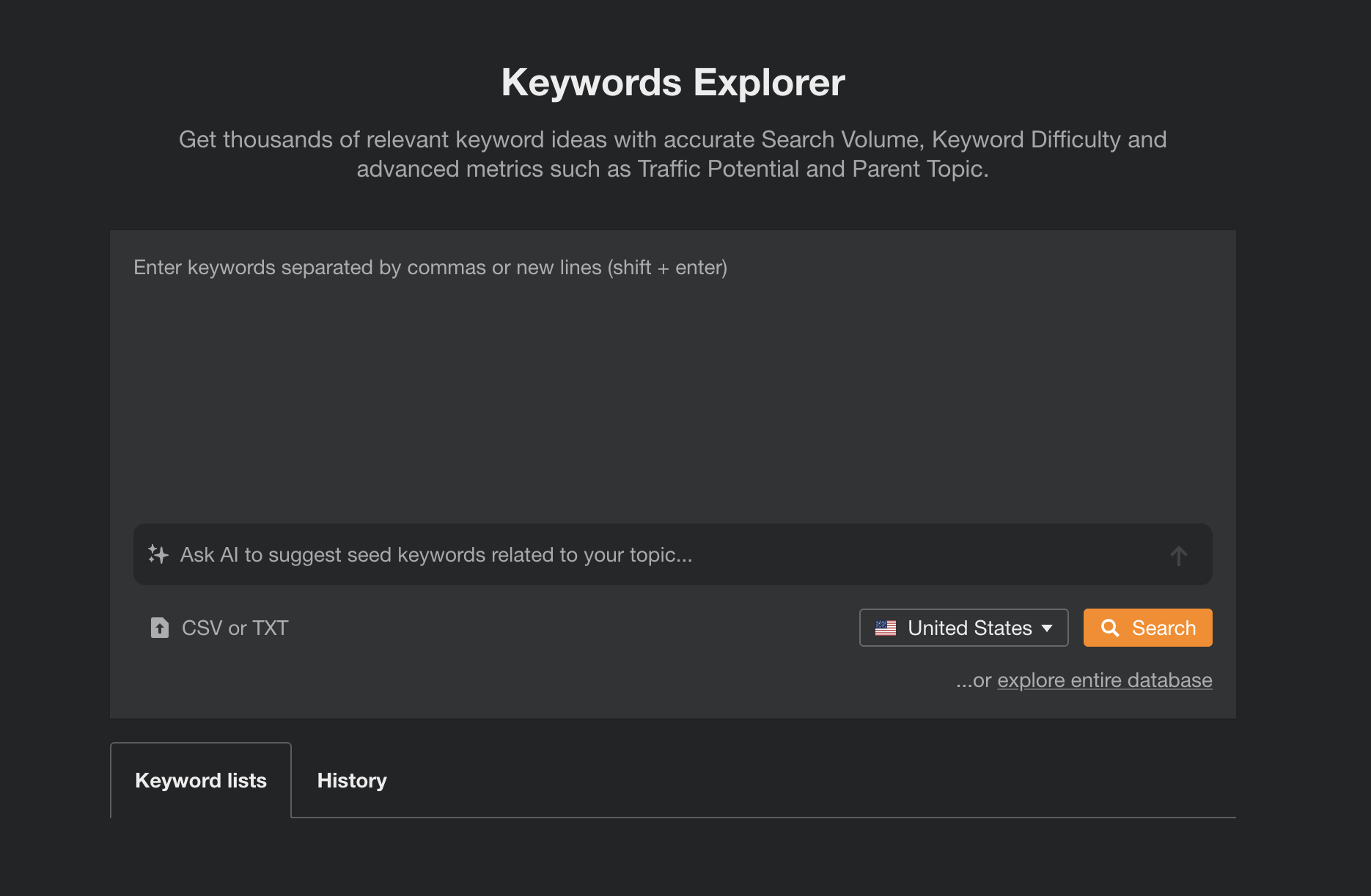
It'll search for long tail keywords and show their search volume, keyword difficulty, and more.
The best way to use it is to filter through the keywords and find keywords with difficulty below 20.

This will actually give you a list of keywords that you can easily rank for.
Whenever you find a keyword that is interesting, you can open it and it'll show you the total traffic potential and other data that is not available in the free tools. It'll also show other keyword ideas that are related to your main keyword.
And it doesn't stop there.
Ahrefs has a lot of competitor analysis features that help you see what keywords your competitors are ranking for. This is good for people who are starting because they can look up the biggest competitor in the niche and just copy what's already working for them.
2. SEMrush
SEMrush is another tool that you can use and I would recommend it as much as Ahrefs. Both of them are to go-to tools for SEO.
The way you research keywords in SEMrush is pretty similar to Ahrefs but with some minor differences. For example the Keyword Explorer is called "Keyword Magic Tool".
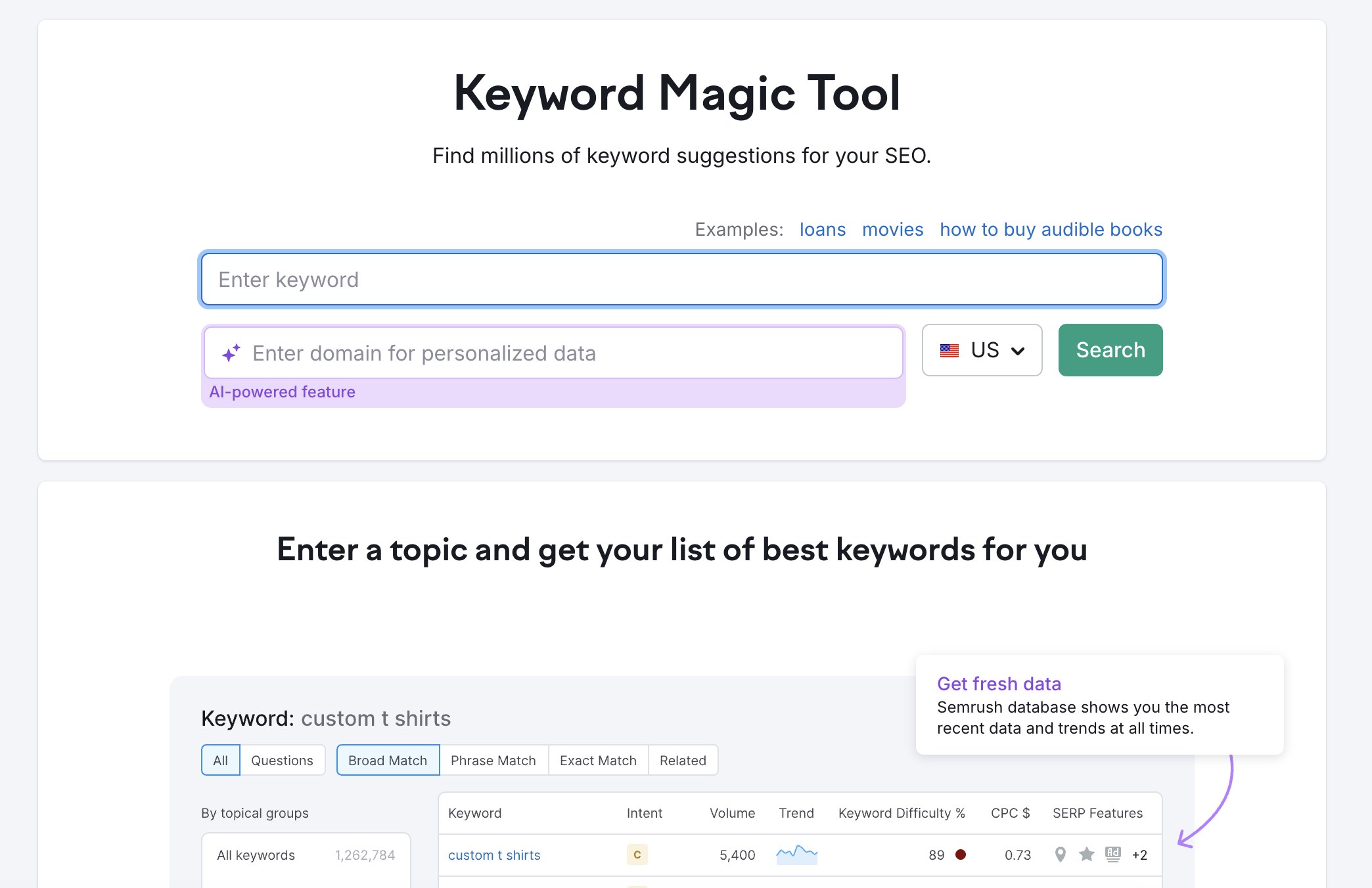
Cheaper paid tools
KeywordsEverywhere
My heart goes out to this tool. It costs around $3-6/month based on your usage and it's so easy to use. It's a browser extension that gives you the keyword metrics directly when searching.
This makes Google autocomplete 10 times better:
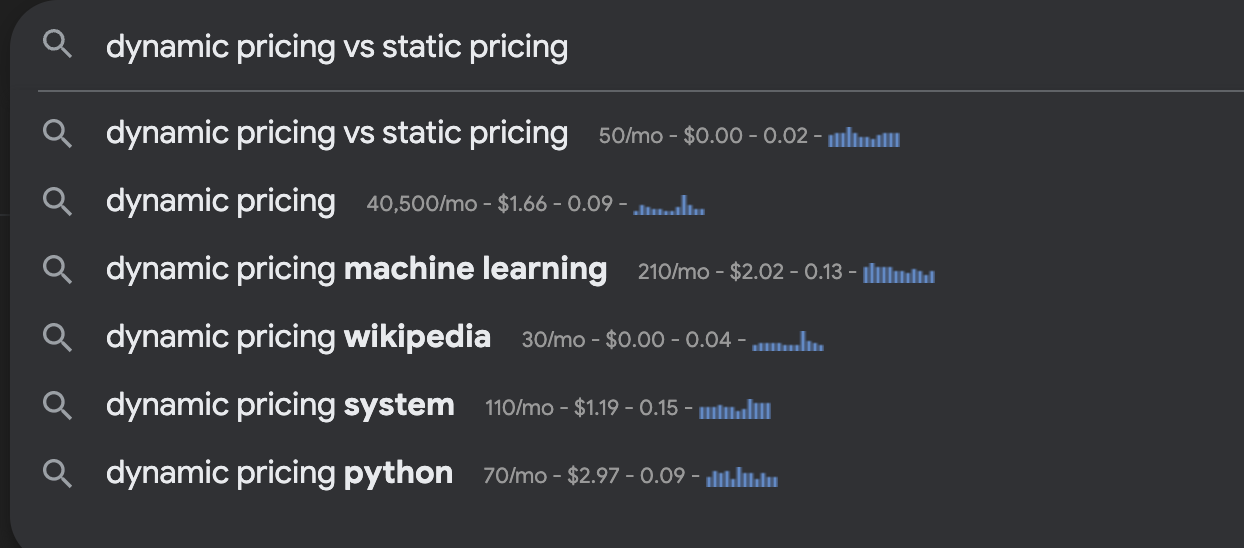
Here's my easy workflow:
- Generate 100 keyword ideas with ChatGPT
- Pick short tail keywords
- Enter in search bar and take a look at the autocomplete
- Pick one of the long tail keywords that got autocompleted and repeat until you have a 0 competition keyword with 50-150 search volume
My personal recommendation is to also look at the actual search results and see if there are any low domain authority websites that are already ranking for that keyword. If you only see 70+ domain authority websites then it's probably not worth the hassle.
How do I use these keywords in my content?
Each of your pages should have a main keyword and then a few secondary keywords. You should avoid creating mutliple pages around the same keyword. This is called keyword cannibalization and it's usually bad for SEO because both of your pages are fighting for the same spot in search results.
I recommend using the main keyword in your H1, meta title and once or twice in the content body. You have to make sure that all of the keywords naturally fit into the content, Google heavily penalizes keyword stuffing.
Module 3: All the ways I know to get more traffic
Targeting buyer intent keywords
This is probably one of the best methods to get traffic to your website because it's the most high quality traffic there is. You're basically targeting people who are ready to buy your solution. Remember commercial intent keywords? We'll mostly be targeting those.
Here's what the keywords usually look like:
- [our product] vs [competitor]
- [competitor 1] vs [competitor 2]
- [competitor] alternatives
- best [competitor] alternative
If you're wondering whether it's legal to use your competitor's name in a comparison page, then the answer is yes given that you don't misrepresent them. Don't take this as legal advice, I recommend checking local laws or consulting a lawyer in your jurisdiction if you're not sure.
You're probably familiar with these pages but there's much more to it than just putting up a "vs" page and hoping that it'll rank.
You need to make the content amazing. (Like really amazing)
Here's a checklist you can follow:
- Break up everything to sections for more readability
- Add social proof
- Use tables for clear comparisons
- Include a quick explainer video
This content should be optimized for humans first and for search engines second. Don't try to do it the other way around because it won't work.
Enough talk. Let me show you how companies actually implement this strategy.
First I'll talk about a company named Podia which is a platform that helps people sell online courses.
Whenever you try to search up "best podia alternative" or "podia vs kajabi" you'll see that Podia always comes on top. Take a look at their pages and see how they're structured, see how they convert attention and seriously try to learn.
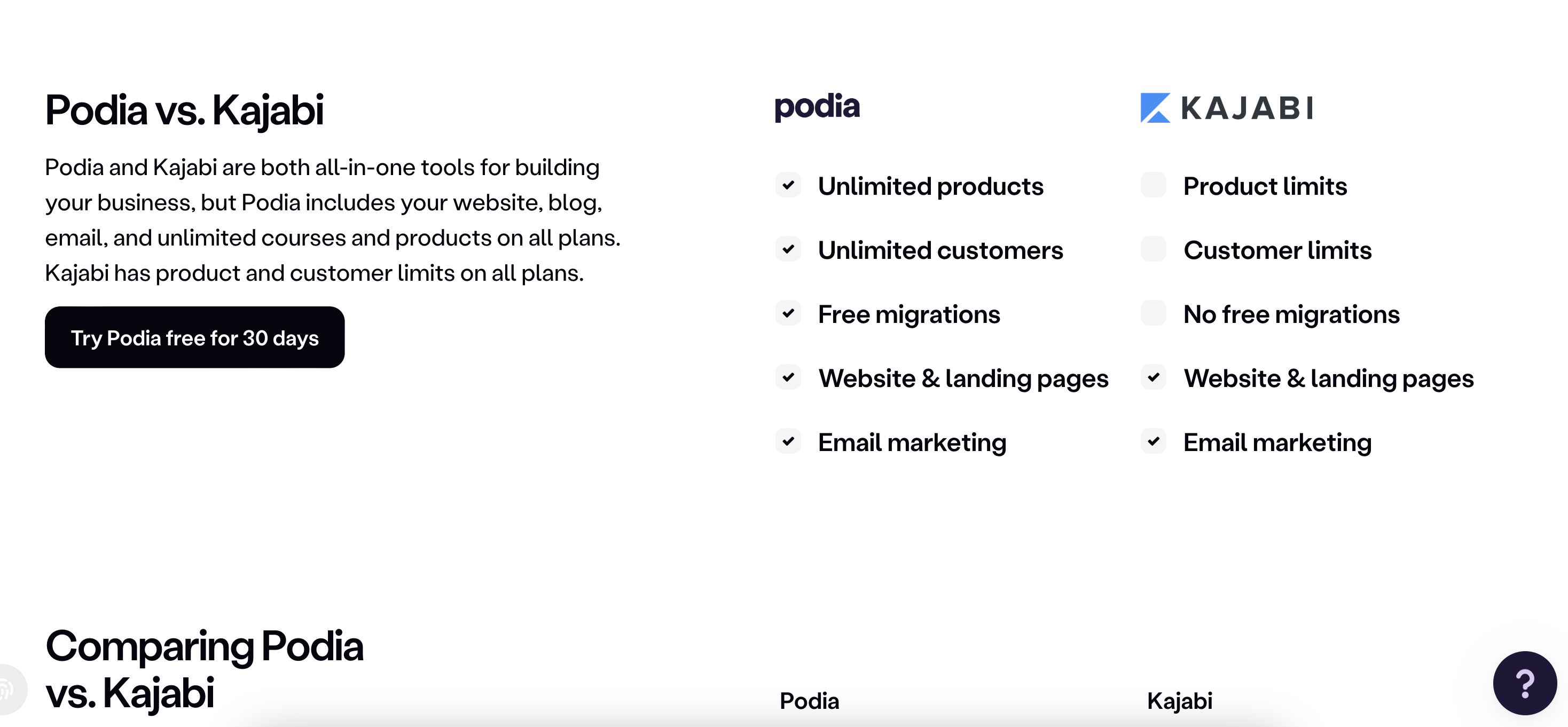
There's a lot of lessons to be taken from them, they rake in around 70k visitors a month which would be equivalent to $33k/mo in paid ads. Do you actually understand how powerful this strategy is?

There's also a few companies implementing this strategy by creating better help pages then their competitors.
You know the banking company called Wise?
They've successfully outranked PayPal multiple times by just providing better support pages.

You can do this for any help related question to the competitor's product. Just make sure to match and exceed the content they currently have. Google will notice that you content is more straightforward and will boost your rankings.
Creating thousands of blog posts with AI
To really make this strategy work, we need to ditch the old mentality.
Previously you had to write a lot of content by hand. This resulted in people focusing only on the most searched keywords with the goal to create the best content possible. However that's just not feasible today. Most people who target these keywords already have high domain authority built up and we won't stand a chance against them.
So what can we do?
We pick the least competitive keywords and create a LOT OF CONTENT.
So go back to keyword research and look for informational keywords that have a really low KD. Ideally below 20. This will give us a good chance to rank. Create a really long list of them. Now start going one by one through the topic and go through this exact process I show you.
First search up the keyword in Google and see what the top 3 results are. Then open those and copy their content.
Copy and paste the top 3 pages content into this prompt below, send it to ChatGPT and it'll give us an outline for the blog post.
Write an detailed blog post outline based on the examples for the keyword: [KEYWORD]
## Examples:
[PASTE BLOG POSTS HERE]
After that's done, use the prompt below and it'll write the full 1700-2000 word blog post.
<guidelines>
All guidelines have absolute priority.
Do not use complex or abstract terms such as 'meticulous,' 'navigating,' 'complexities,' 'realm,' 'bespoke,' 'tailored,' 'towards,' 'underpins,' 'ever-changing,' 'ever-evolving,' 'the world of,' 'not only,' 'seeking more than just,' 'designed to enhance,' 'it's not merely,' 'our suite,' 'it is advisable,' 'daunting,' 'in the heart of,' 'when it comes to,' 'in the realm of,' 'amongst,' 'unlock the secrets,' 'unveil the secrets,' 'transforms' and 'robust.' This approach aims to streamline content production for enhanced NLP algorithm comprehension, ensuring the output is direct, accessible, and easily interpretable.
Go into extreme detail and make it as long as possible.
AI markers ruin the text for the reader.
The structure for each section should very different to the others.
Avoid these AI markers:
- Overly Precise Number Ranges
- Template Style Comparisons
- Perfect Parallel Structures
- Overly Precise Percentages
- Formulaic Transitions
</guidelines>
Now write an extremely detailed blog post based on the outline, length is 2500 words, use markdown, comply with all of the guidelines and fully avoid all AI markers.
You might've noticed that this prompt is a lot more complex than a classic "write a blog post" prompt. I spent a lot of time trying to make the output sound more human. If you ever used ChatGPT before, you'll know that it has these markers that give off the text as being written by an AI. An example of this would be "In the ever-evolving world of..." and other similar phrases. We want to avoid this at all costs.
A big question I get asked all the time is whether this will pass AI detectors.
The truth is that Google doesn't care at all and won't penalize you for using AI as long as the content is valuable. That includes making the content readable for humans.
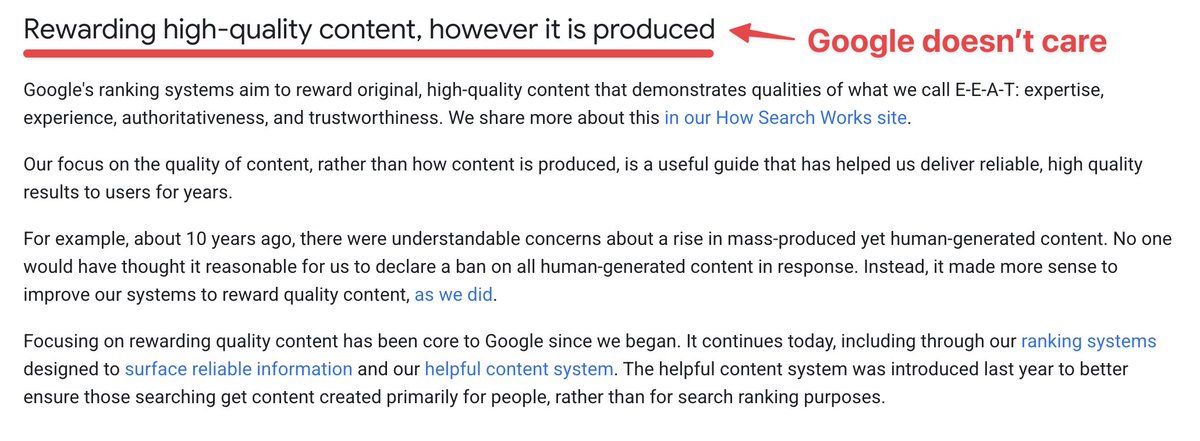
Now that we have the blog post ready, there's a few things we can do to improve it:
- Generate images with flux
- Embed relevant youtube video to keep visitors longer on your page
- Manually improve H1 tag for better CTR
Note that these steps are optional but they'll help you get more traffic.
After that's done just publish it to your blog and repeat this process as many times as you can.
You probably noticed that even though it's faster then hiring a writer, it's still a lot of work to make this work at scale. Many companies like us are already creating solutions to this problem and I believe it's important to give you multiple options so you can choose the one that works the best for you.
Here's the tools:
- Contly AI - Writes and publishes 1 blog post per day directly to your blog and finds low competition keywords for your website.
- GravityWriter - Writes a blog post for the topic you choose and publishes it to Wordpress.
- SurferSEO - Writes and improves your blog posts based of your competitors.
- Jasper - Writes blog post for a chosen keyword as well as other content types.
- Copy.ai - AI that specializes in copywriting, can write blog posts, landing pages, etc.
Make an educated decision and go with the one that works the best for you. Our software has a free trial incase you want to see whether it's a good fit for you.
Programmatic SEO (pSEO)
pSEO is pretty different from all the previous strategies we discussed. It's strategy where we generate hundreds of pages at scale via code.
The other strategies I described are primarily focused on growing traffic for product that already exists. pSEO is different because it only works for certain products. You need to have something I would call a "pSEO opportunity".
Here's how you can spot a pSEO opportunity:
- There's a dynamic variable that can be swapped out, e.g. "photoshoot in [city]"
- People commonly search for different variations
- You can generate unique and valuable content for each variation, no copy and paste
The good thing about pSEO is that it's very easy to scale and can give you extreme amounts of traffic but remember that you won't be the only one doing this. pSEO is a very competitive space so you need to make sure your content is much better then the competition, that includes making it:
- easier to use
- aesthetically pleasing
- as unique as possible for each page
Let me show you some real examples of pSEO:
1. LandingFolio
A website that shows the best and trending landing pages.
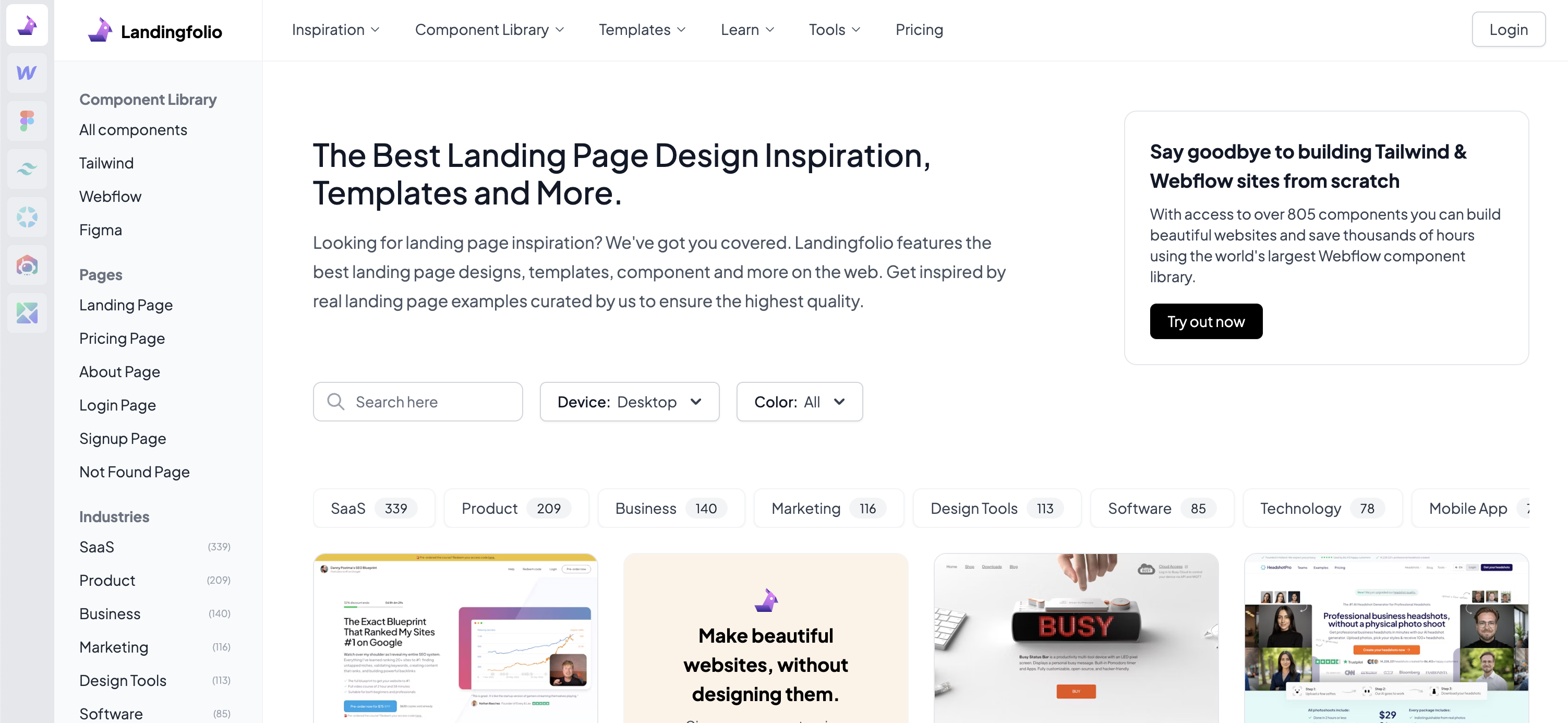
2. Lumenor AI
They generate AI images, categorize them and show those categories on different pages.

3. Nomads.com
Website shows best travel destinations, each on it's own page.
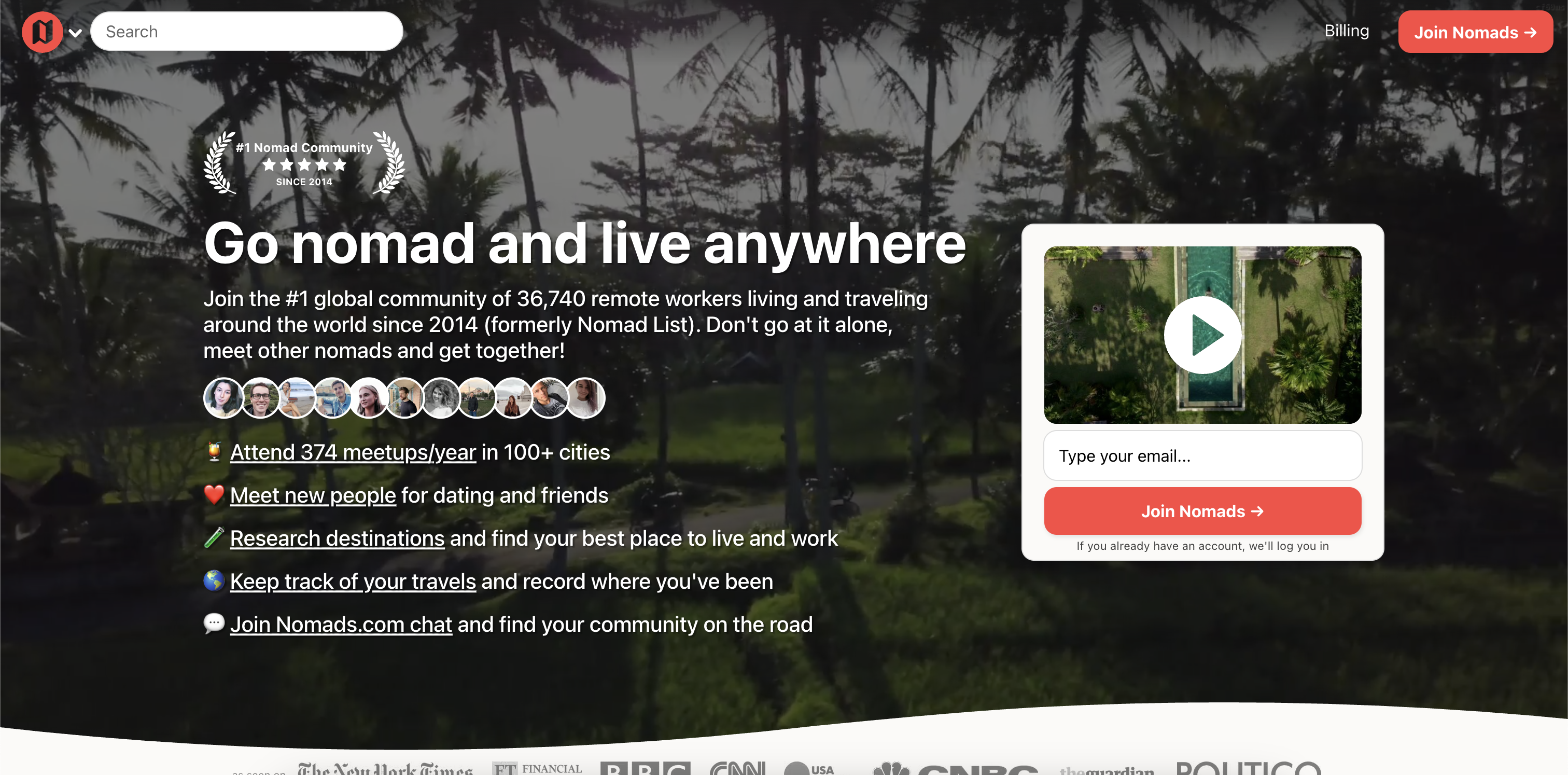
pSEO is great but if your product doesn't fit this strategy then don't worry, you can use any of the other strategies and do just fine.
Module 4: Building authority in your niche
Now that you know how to create content, let's circle back to building domain authority for your website. This module will be focused on the different ways you can obtain backlinks.
Submitting to directories
By far the easiest way to get a few links to your website. The problem with this approach is that it's so easy and everyone does it so it's not much of a differentiator. Consider this as your starting point.
Here's a list of 50 free directories you can submit your startup to:
50 free directories to submit your startup
HARO (Help a Reporter Out)
HARO is a platform that helps reporters by connecting the with experts. Reporters are usually looking for sources and expert opinions in exchange for a free link back to your website.
If you're wondering what's cool about this strategy then you need to check out the domain authority of the websites these reporters are usually writing for. You'll see big names like Forbes, The New York Times, TechCrunch and most of them have a DA of 70+.
Do you know how much of a boost this would give to your site? A lot.
The hard part about this approach is that it takes a lot of time. You'll be answering questions for a long time without anything in return but you'll see that it's worth the effort once you get a backlink to your site.
You can sign up here: https://sourceofsources.com/
Link stealing
You need to first find your biggest competitor and see who links to their site. All of this can be done through Ahrefs and SEMrush.
As sneaky as it sounds, this approach is just about reaching out to the sites that link to your competitor and asking them to link to you instead. You can convince them by showing off that your product is superior or by simply paying them.
Here's a short e-mail script template that you can use but make sure to customize it to your industry:
Subject: Quick question about article on [topic]
Hi [name],
I saw that you mentioned [competitor] in your recent article on [website].
Our product solves a similar problem but with these benefits:
- [benefit 1]
- [benefit 2]
- [benefit 3]
Would you be willing to add or replace the link with ours if it provides more value to your readers?
I'm more than happy to provide additional info.
Thanks,
[your name]
Affiliate programs
Affiliate marketing can greatly complement your SEO strategy. For those of you who don't know, affiliate marketing is just paying a percentage of your revenue to the person who brings you a customer.
People who are already paid to promote your product will naturally link to you.
Here's a few platforms I would recommend for creating affiliate programs:
A good example of this is Crayo.ai which has a around 1.2M backlinks. This is mainly because of their huge affiliate program.

Exchanging links (with caution)
You can reach out to other companies in your niche and offer them to exchange links. You need to be very careful with this approach. The site needs to be really relevant to your niche and you shouldn't overuse this approach otherwise Google will realise what you're doing.
What to avoid when link building
You should at all costs avoid the link building techniques I'm about to describe. They might work for a month and boost your traffic a little but your site will get absolutely demoted and deranked by Google once they realise that all of the backlinks are not legitimate. And trust me, it's not hard for them to detect.
Avoid this:
- Low quality backlink buying (bought from fiverr or similar marketplaces)
- Private Blog Networks
- Link Farms
- Spamming your website on Reddit, Quora, etc.
- Over-optimized anchor text - placing keywords directly in the anchor text when someone links to you.
Module 5: Converting traffic to leads
So now that we have a lot of traffic coming to our site, we need to actually convert it into customers. You need to realise that traffic is a vanity metric at the end of the day and the real outcome of SEO should be sales.
First we need to make sure that our content actually matches the search intent of our traffic and that the keywords we are targeting are actually relevant to our product. If wrong people land on our page then we stand no chance in converting them.
Once the traffic is relevant, then the only way to convert more people into customers is by doing CRO. (Conversion Rate Optimization)
Like with everything, the main thing that'll affect your conversion rate is your offer.
Forget about charging people right of the bat. They are completely strangers and asking them for money at this stage makes zero sense. Instead create a really good offer, you can do this by offering them a lead magnet.
If you're not familiar with the term "lead magnet" then I'll show you a perfect definition from Alex Hormozi:
"A lead magnet is a complete solution to a narrow problem."
So it's not a partial solution but rather a solution to a very specific problem that naturally leads into your core offer. It should be free, easy to consume and actually valuable to the prospect.
Good lead magnets:
- Free 7 day trial
- Free tool to solve a very specific problem
- Cold email outreach template for [niche]
Bad lead magnets:
- 56 page PDF on CRO (Whos's seriously going to read that?)
If you're selling software, then you'll be just fine by offering a generous free trial without requiring a credit card.
Now that you have an offer, you need to prominently display it on your website. Let's say that you have a blog post. There should be at least 3 different CTAs.
Here's an example from Podia's blog:
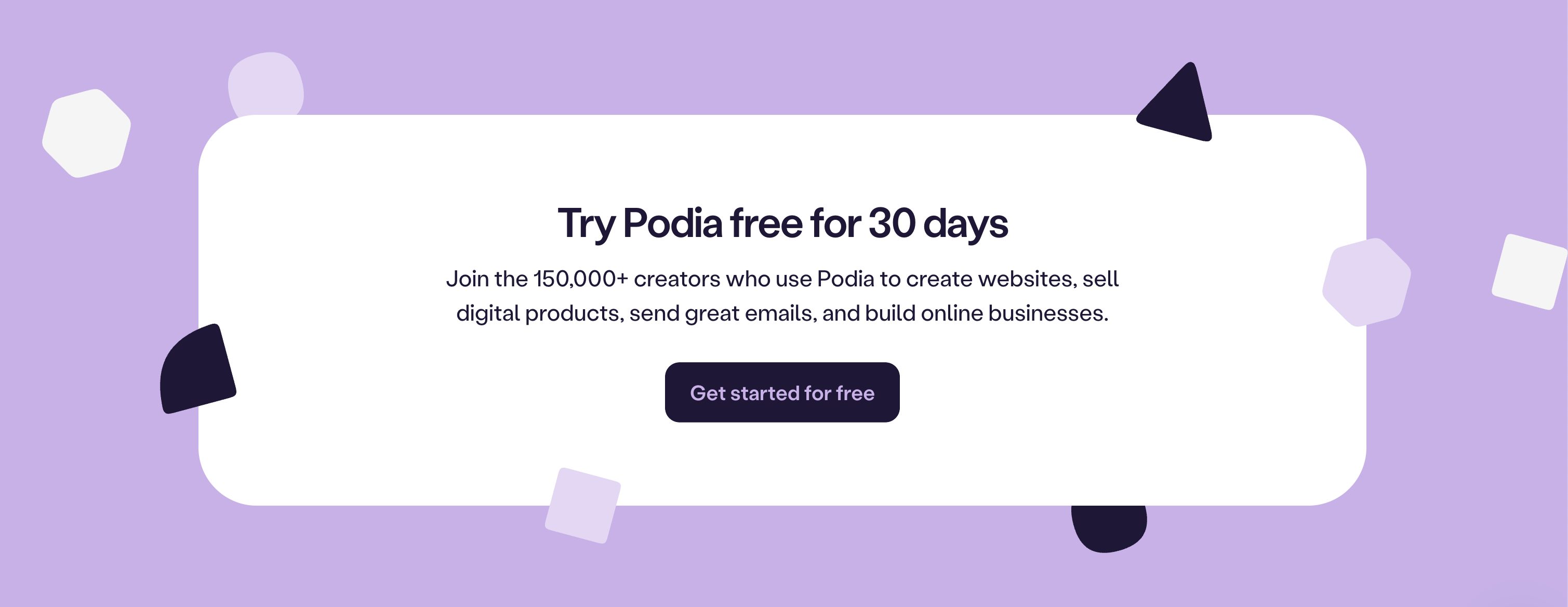
Make it easy to click, add elements of risk reversal such as "No credit card required" and add social proof because that's one of the biggest drivers of action.
Module 6: I have done all of this, what do I do now?
Tracking performance
You won't be able to do anything without having the right data. It almost surprises me how many people don't track any data at all. The first thing you need to setup is Google Search Console. Just connect your website and it'll start tracking all of the traffic and views in search results.
It's also very useful incase you have some issues with your website that prevent it from being indexed. Google will automatically send you an e-mail and tell you what you need to fix.
So now that you have that setup, you need an analytics tool. I personally recommend Plausible because it's very easy to use compared to Google Analytics and it's GDPR compliant by design. Here's a few other options:
Whichever one you choose, you need to setup proper tracking and events that fire when a user signs up from your CTA. It's best to track the whole funnel because it allows you to see where the drop offs happen and optimize for them.
Other metrics that you should track are:
- Bounce rate
- CTR (Click through rate)
If your bounce rate is high then your content needs some work. If your CTR is low then you should improve your titles and meta descriptions to make more people click from search results.
Maintenance
Some people think that SEO is a one time thing where you just publish some content and it'll rank forever. That's far from the truth. SEO needs continuous work and maintenance otherwise your rankings will drop.
This means refreshing your content from time to time with fresh insights. Keep an eye out on the search intent of the keywords you're tageting because it can actually evolve and change. A keyword that was once informational may now become transactional in a form of a free tool.
Whenever that happens, you need to adapt your content fast.
Another measure you should take is to track your competitors on a regular basis. Modern tools like Ahrefs and SEMrush allow you to do this very easily. Once you setup tracking, you'll be able to see keyword gaps and backlinking opportunities your competitors are using but you're not.
The thing that can mess up your whole rankings the most are Google's algorithm updates. Google is constantly updating their algorithm to prevent spammy content and websites. As long as you're providing value to you audience and you're not using any black hat techniques, then you'll be fine.
It's good to check these updates out though to make sure you have a rough idea of what's going on.
Conclusion
Thank you for reading this whole course. I tried to make this course as actionable as possible because I personally despise long courses that talk about fancy terms and that show strategies that only work on paper.
If you have any questions, feel free to reach out to me on Twitter or email.
Cheers, Ondrej
